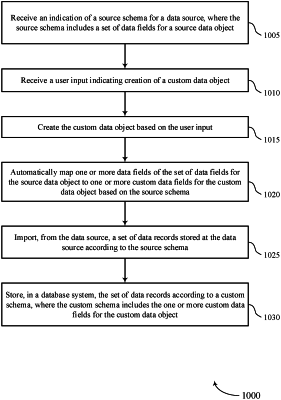| CPC G06F 16/213 (2019.01) [G06F 16/2379 (2019.01); H04L 63/08 (2013.01); H04L 63/126 (2013.01)] | 20 Claims |

|
1. A method for data mapping, comprising:
importing a plurality of data records from a first data source and a second data source to a database system in accordance with a first source data schema and a second source data schema based on performing an authentication procedure which includes receiving authentication information for the first data source and the second data source from a user device;
storing the plurality of data records in a data lake of the database system in accordance with a custom data schema different from the first source data schema and the second source data schema;
creating a custom data object that includes data from the plurality of data records stored in accordance with the custom data schema, wherein creating the custom data object comprises using a natural language processing (NLP) model to map fields of two or more data records associated with at least one standard data object and at least one hybrid data object from different data sources to fields of the custom data object based on determining that the two or more data records correspond to a same user;
receiving, from a cloud client, a query that includes a search criterion associated with the custom data object; and
querying the data lake of the database system to retrieve data from the at least one standard data object and the at least one hybrid data object that are mapped to the custom data object based at least in part on the search criterion associated with the custom data object.
|